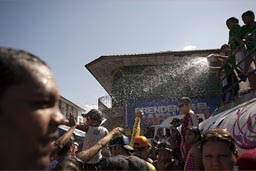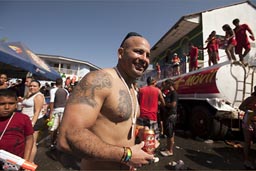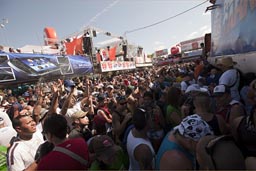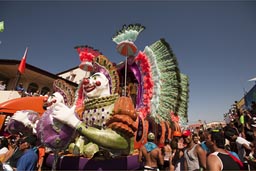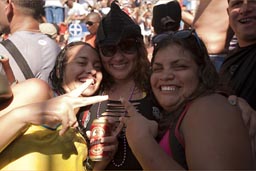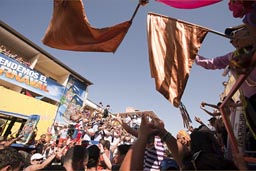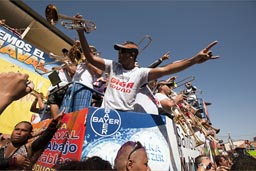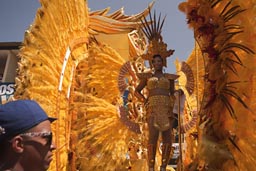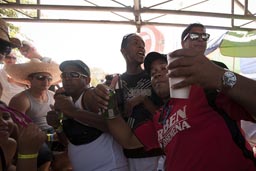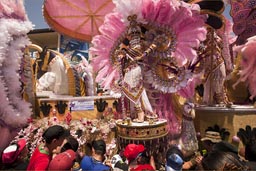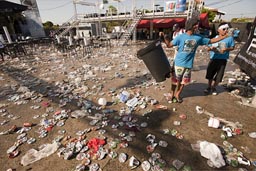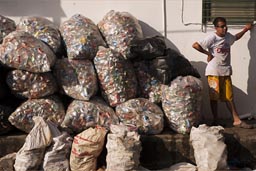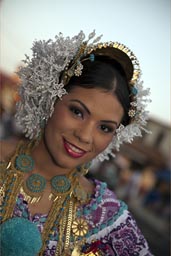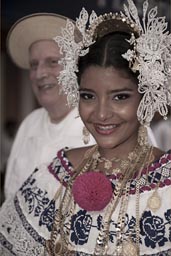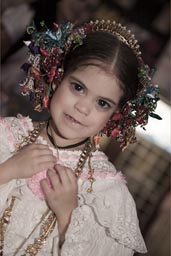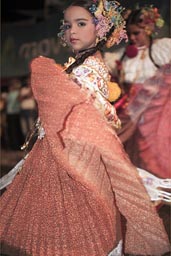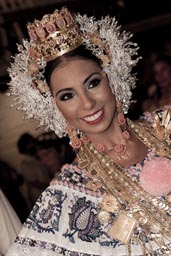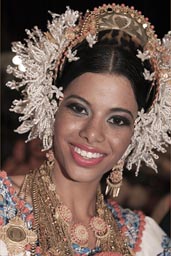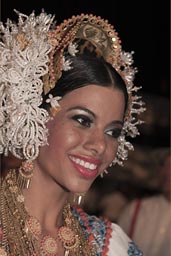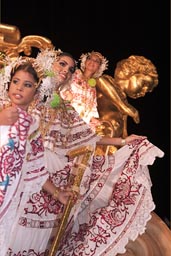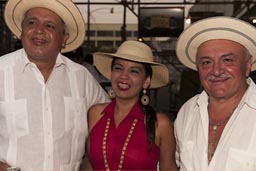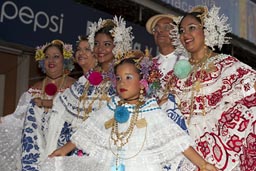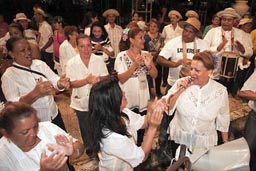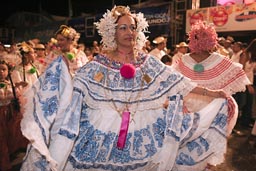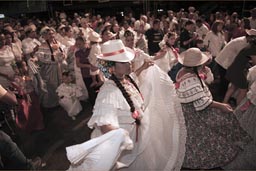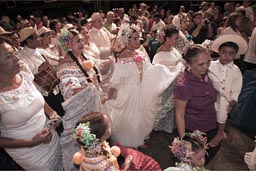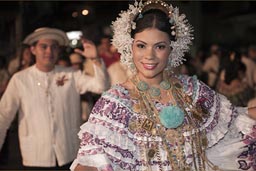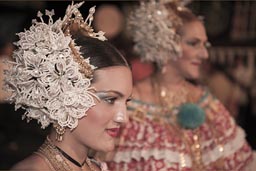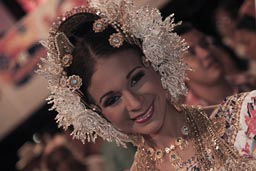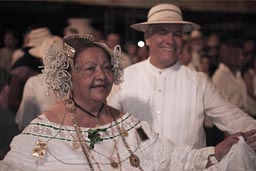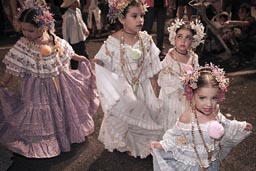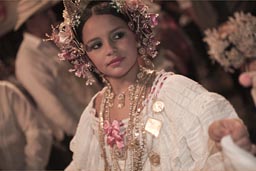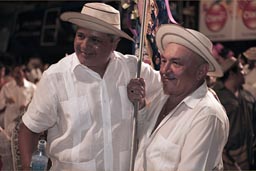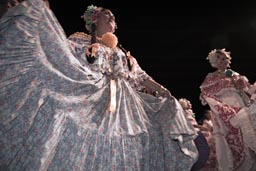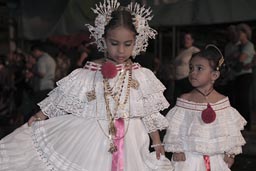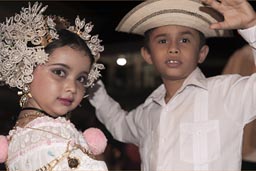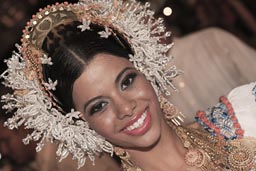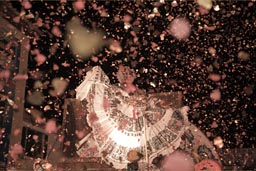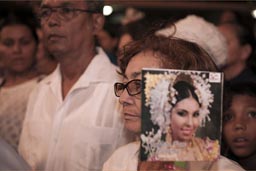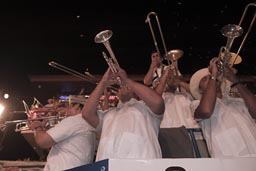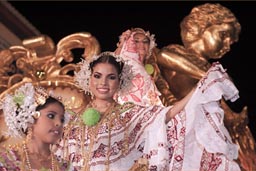www.thisfabtrek.com > journey > central-america-caribbean > panama > 20120220-las-tablas
Those crazy carnival days.
"Viva el carnaval" Christina triumphs as she wakes me pouring water over my cheek and in my ear and gives me a little sense of what we are up to over the next 4 days here in Las Tablas in the province of Los Santos, this is the beginning of the world famous Carnival of Panama.
2 hours later after eggs and coffees we are out and inside the chaos past the security checks and now surrounded by strong, big men and women, many far beyond 100kgs in weight, and as a sign of belonging to the carnival every family pulls or pushes along its own eskimo box full of cans of beers, some truly resemble small sarcophaguses. Right then after the entrance all jams already as a monster long-haul cistern truck, 30 tons at least, reverses to turn the corner in these narrow streets to find its designated spot, to make room the police shove us to all sides. The bodybuilding men and outgrown women who guard their eskis like hen their chicks don't move neither fast nor much, my head runs into some huge pair of breasts, while Christina's long legs help her over the line of rolling sarcophaguses. I point her to a sign that says bar, 1st floor, billiard and we escape. A beer in hand still before noon we watch the cramming and pushing down unfold. Some climber kid connects the speakers atop of the cistern truck with the lines of the two big DJs next to me on the terrace, and then the Reggeaton beats start hammering, while my big men DJs who never allow for a smile shout some unrecognizable babble in their microphones.
The crowd cheers them in agreement and cheers again the sprayer-chicks on top of the cisterns when they start unloading their huge reserves of water in this steaming hot mid day in an otherwise baking concrete jungle. This tradition of throwing water is called culecos, our all in hot-pants and bikinis, half-naked water canon girls target other naked bodies and bellies, they also throw give away t-shirts and caps of network providers and phone companies, the street jumps for anything. TV is all present too as this is as much a commercial show as a traditional carnival and a communal orgy sells. Every boy and girl has his or her hang-loose fingers and thumbs-ups in the air, today everybody's cool, this is the time in the year, long, long hyped up as a weekend of limitless joy, no rules and no tabus, anything can happen and happens.
The day of all days only commences when a first float pulled by a tractor slowly rolls around the corner and approaches the main plaza. These trailers are elaborately decorated with golden Greek Goddess like figures and statues, feathered beauty queens dance slowly atop, who know how little to move their brown nylon hips so their feathered backs swing slowly enough. It is then that the spraying stops for a moment so to spare the queens and their expensive costumes damage. A colorful queens float is always followed by a wagon carrying the brass-band, the murga, and the water canons immediately resume work giving full attention at the maddest wind and percussion section of 30 men and women squeezed in several tight rows on top of a hay wagon. The screaming Banda jazz and its wild rhythms carry the wet soaked audience to ever new extremes, dances become more acrobatic and the drunk roars demand spraying for band, people, party, God and country, may we have beers forever.
To the foreigner, and this is us, all is quiet the same, one cart, one band, one after the other, all different carts and one nicer, more colorful than the other, different queens, one costume or theme better than the other; and exiting extravaganza. But to Panamanians it all has a lot more meaning, it is competition between two tunas, two ends of the same street in Las Tablas and their following equipage and fan clubs, Calle Arriba (Uptown Street, or Highstreet) and Calle Abajo (Downtown Street). It is the competition for the most elaborate float, dance, performance, dress, costume, feather gear, fireworks and a lot more (wiki).
On our terrace too, throughout the afternoon the cerveza count has gone up as more floats roll by the main square and around it and the beer sarcophaguses in the streets become empty. Some first big bodies already stumble towards the exit, then stop and ritually dance around the almost empty eski-box and maybe fish out a last drink and pour the ice water over their sun burnt, glisten skins. The light of the late day and the thinning of the crowd in the streets now seem right to us and we head out to capture some closeup interaction with the ongoing party.
Music in Panama, Alfredo Escudero, accordion.
Darkness has yet to fall when we come back to our already favorite bar outside the carnival zone. In Panama, unlike Costa Rica, beer is just 75c or 65c of a dollar, here the average person can afford a drink, can even invite a group on a good day, so many times I find myself on the receiving end and thank the stranger at the other side of the room. A video juke box clangs out high pitched accordion sounds, with some refreshing screeching chants, the songs go by 'Tipico' or 'Cumbia', if a genre can apply. One musician sticks out these very days, Alfredo Escudero with wild chimes that border the psychedelic, a jazzy soloing to the griot chants of his wife, so African I wonder, and guitars too, and drums like Guinean djembes.
Three days ago and fresh in Panama we entered our first bar in David, I have realized it then: Panama has a mystical side that surprises the unprepared, takes him on a musical journey where the beginnings and ends of creation and fusion remain blurred. Full nights of accordion, and the heart is taken up and down with eyes closed and along the beats, when the hips that never moved by themselves, move. I now seem to understand Nobel laureate García Márquez, when he writes about this instrument, the nights, booze, dance, women and love; these songs make the average person get up and dance and the old man sit down and cry. In the 1800s the mystical accordions, so the tale goes, were washed ashore in Columbia and Panama was then part of it, coming from a shipwrecked German cargo. The ground they fell on was diverse and fertile: the Caribbean African slaves had mixed with Whites and Native Americans for centuries, had intermarried their musical traditions and the new instruments were take in a stride since then, the Cumbia style and Vallenato developed. Just todays Panamanian protagonists reach beyond the folkloric traditions.
Our musical, Latin journey has commenced in Mexico where we encountered much of a Ranchera forever red-neck tradition, in Guatemala the dust piled 10 inches high on marimbas, a government ordered preservation project. Nicaragua and El Salvador have an interesting revolutionary songs history from Sandinista and civil war times, Costa Rica then was rather dead and flat music wise, Beatles, Bon Jovi and Elton John in tourist traps, yes truly horrible!
Now, Panama is different, is Caribbean, and it has a tradition when it comes to innovations: Reggaeton, with El General regarded as the Godfather of Reggae en espanol in the 1980s ad 90s was in some way created on the isthmus, and it spread to Puerto Rico and Jamaica and around the globe. Yes, in todays Ivorian rhythms I can clearly hear the Reggeaton origins! But I hear the Guinean Bambeya Jazz guitars from the 1960s, in todays Cumbia, I hear the African drumming and the Malian griot chants. I think of the government sponsored musical cross pollination programs between Cuba, Mali, Guinea and Ghana in the 1960s and 70s, peoples democracies' solidarity at works. But which way did the guitar playing styles move, which direction travelled the chants and the drumming?
So I wonder here in the bar after the carnival, and think this is simply the Caribbean and a melting pot, and, let's just enjoy listening and not over-analyze this beery night...
To the carnival we go back many times, only Sunday when all Panama seems to descend on Las Tablas we give it a miss in light of the congestions done by rows and rows of coolers and their 100 and plus kilo folk protecting them. The bigger the body the more it refuses to move by even an inch when you want past them as if they have rented the very space on the street; but for some moving means stumbling over the neighbors eski-box even in the early hours and if one of the heavy drunks falls on me I am dead.
La Pollera Panameña, Panamanian Pollera Dresses, Carnival Queens, gold and brown.
Tuesday night then is different, a finale special evening; after the cleaning of the main square off all the empty beer cans, just at dusk and like in a fairy tale the queens and potential queens come out from under the pavement, from kid's to granny's age, in company of husbands, friends and followers, the tunas from either Calle Arriba and Calle Abajo. Gone are the shorts and strings and gone the drunken naked. Tonight is the night of the Panamanian pollera, a definer of what the Panamanian woman stands for. Dresses and outfits are the most exquisite, clothes and embroiders, folds and forms a patrimony of femenine spirit, hand-crafted over hundreds of hours; some polleras take 8 to 12 months of work till finished. Elaborate crowns and headgear, tembleques, for queens and those who will or might be queens one day are part of the pollera, so are gold necklaces and jewelery and the more and heavier the better, it all embellishes the Panamanian beauty; all enhances rank and status and a solid and growing following base as for a queen to become queen it takes from early childhood (4), some ten, maybe fifteen years of preparations, a strong family backing and commitment of time and money, and foremost and ability to smile and dance till the end of times.
So then it happens to me again, that these chants by the thirty or more musicians, drummers, singers and followers that make the tuna that succeed the golden beauties in their polleras in the carnival processions, remind me of the calling and repeating in African griot singings. The tunas go round and round the square many times, in small steps, constant clapping to the monotone beatings of African drums, I flash my eyes open in disbelieve, they are white! The moves of hips and steps are intensely similar to what I have seen in some Malian song/singer/dancer (griot) contest (Segou 2005), the griot callings, the raising of voice and pitch equally resembling and again I content myself and not wonder further: this is the Caribbean and a melting pot and who knows what twisted paths these songs have taken.
www.thisfabtrek.com > journey > central-america-caribbean > panama > 20120220-las-tablas


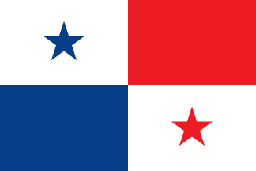
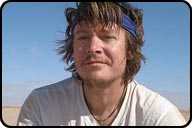
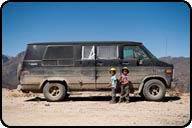
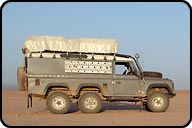


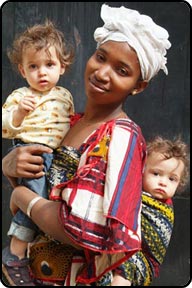
 contains Festival/Fiesta/Art photography.
contains Festival/Fiesta/Art photography.
